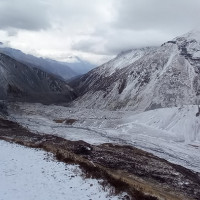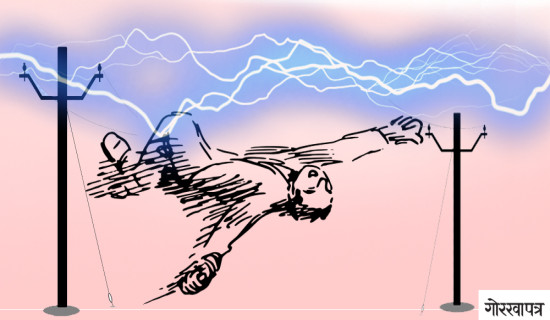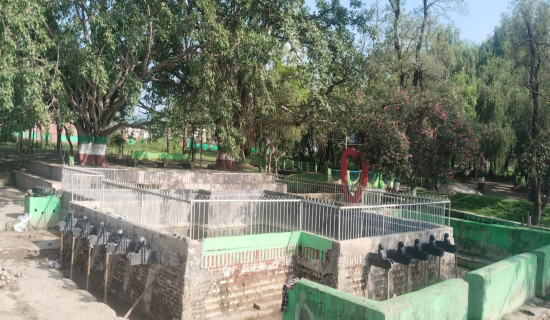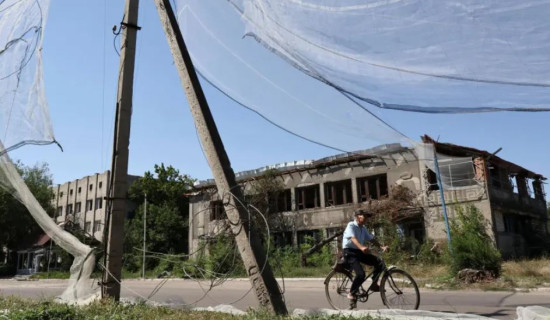- Thursday, 17 July 2025
Paradigm shift in Teej celebrations
By Arpana Adhikari/Purushottam P. Khatri,Kathmandu, Sept. 10: Teej feasting is now at its peak although the actual festival is still a week away. Women attired in all red dancing in groups in the party venues and homes which we notice almost every day signals the arrival of the popular annual festival of women.
Women in every household of the urban areas are now busy throwing or attending the Teej party. Organisations and cooperatives are also hosting Teej feast for their women employees and members. The party venues which remained almost deserted since mid-July are now crowded with Teej revelers.
However, except for the revelers themselves, others are not in celebration mood this year as the Teej failed to revive the economic activities affected after the COVID-19 pandemic and the Russian invasion of Ukraine.
There are others who are not happy with the aberrations in Teej celebrations. They argue that Teej has gradually lost its religious and cultural values and turned into a rather extravagant event.
According to actor Ramesh Budathoki, the Teej and Dar Khane festival have lost their 'organic' taste.
The Haritalika Teej, a festival associated with Goddess Parvati, falls on the third day of Bhadra Krishna Pakshya. Traditionally, Teej is a three-day affair—Dar Khane (feasting day), Teej (the fasting day) and Rishi Panchami. The women feast on the second day of Bhadra Krishna Pakshya and fast (without taking even water) the next day.
In villages, the Teej is still limited to two days. But in cities it is extended for almost a month.
According to the mythical story, Parvati had an unending devotion to Lord Shiva, but her father, Himalaya, chose to fix her marriage with Lord Vishnu. This was unacceptable to her, so she had her friend "abduct" her and hide her in the forest.
Eventually, Parvati succeeded in marrying Shiva and the plan she hatched to make it possible – to be abducted (Harit) by her female friend (Aalika) – gave the festival its name Haritalika.
Similarly, as it is celebrated on the third day (Tritiya) of the bright fortnight of the Nepali month of Bhadra, it is called Teej.
Some scholars, though, believe that 'Teej' is the corrupted form of 'Treej'. Treej used to mean that the festival of Haritalika becomes especially auspicious if the Bhadra Tritiya falls on a Monday during the Hasta constellation. Treej signifies the need for these three things.
This year, the festival of Teej falls on Monday (Sept. 18).
Until a few decades ago, Teej used to be a festival of reunion between parents and their married daughters. No matter how far they were married off, fathers or brothers of the woman visit her a few days before Dar Khane day and bring her to their home.
Mostly, by the day of Kushe Aunsi, most daughters and sisters used to reach their parents' home to enjoy Dar (delicious food) of Teej. The celebration of Teej is so entrenched that the age of sisters or daughters does not deter the men from visiting them to invite their siblings or daughters on Teej.
Dhanamaya Acharya of Ilam Municipality-11 is now 93, and until last year her brother Dhana Pati Dahal, 86, of Deumai Municipality-6 in Ilam used to visit her home to invite for Teej.
"I am not sure whether he will come or send someone to invite me this year ," Dhana Maya said over the phone.
Traditionally, Teej is a celebration of sisterhood, as sisters gather at their parental homes, embracing the joy of jubilant dancing and harmonious singing. However, the festival has evolved over time, reflecting the shifting societal roles of women.
Prof. Dr. Beena Poudyal, retired head of Tribhuvan University's Central Department of Nepalese History, Culture, and Archaeology, said the majority of festivals in Nepal have strong links to religious backgrounds, and Teej is not an exception.
She shared the growing popularity of Teej stems from its profound religious, social, and cultural importance in the Nepali society.
“In our society, women traditionally move to their husband's family, often making numerous compromises to adapt to their new household. This , at times, restricts their freedom in terms of food, clothing, speech, and entertainment," she explained.
So, this festival also holds psychological importance , as it enables women to celebrate at their parental homes, providing them with a sense of refreshment, said prof. Dr. Poudyal.
“For a long time, the festival remained an occasion where married women share their ordeals and sufferings they face in their husband’s place, through the songs and dance, especially while they visit their parental home.”
This is why we have innumerable Teej songs. However, there is no single film made on this festival. Filmmakers Prakash Sayami and actor Ramesh Budathoki also said that no film on Teej was produced in Nepal although some films have featured Teej songs.
Coincidentally, Teej falls when the people, most of them farmers, complete the tedious tasks of planting paddy and millets. The timing is perfect to bring back their married daughters/sisters and offer them delicious foods for a few days during Teej.
However, over the years, a paradigm shift can be noticed in Teej celebrations. It is no more a festival of Khas Arayas alone. Women from other communities, as reported in this and other dailies, have also started joining the Teej celebrations. Prof. Dr. Poudyal also said that the paradigm of Teej has shifted from being a festival of fasting for husband to women enjoying themselves and their independence.
“Unlike in the past, women are no longer confined to their households. They are more educated, independent, politically and economically empowered. More women are now becoming social beings. This is why there is a significant variation in the manner in which Teej is observed,” she added.
Teej celebration, which was limited within the maternal home, is now observed on a larger scale and celebrated weeks before the day of the festival by throwing feasts at the party palaces and eateries.
Women are spending more on designer clothes, beauty salons, among other fancy things. Laxmi Khanal, a former journalist and freelance writer, believes that Teej feasts are occasions for women to come together and celebrate, enjoying delicious food and socialising with friends, colleagues, and relatives.
However, Namita Thapa, a housewife of Thimi, shared her concerns regarding the changing dynamics of Teej.
In recent years, she has noticed a shift in focus from the festival's original purpose and significance to fashion-oriented events.
Thapa believes that many people have lost sight of the festival's originality and the values it represents.
Prof. Dr. Poudyal encouraged people to remember and embrace the original spirit of Teej, emphasising the importance of family, tradition, and spirituality.
Khanal also believes that while it's fine to appreciate fashion and new trends, it's equally essential to preserve and cherish the cultural and spiritual aspects of this age-old festival.
Despite growing commercialisation of Teej, the businessmen are not happy with the Teej-time business this year.
Teej was a time for many to buy gold ornaments until before COVID-19 pandemic. But this year it is otherwise; gold traders have said that the daily trade of gold is hardly 10 kg this year.
The demand for gold has remained lowest during Teej this year, said Tej Ratna Shakya, a gold trader.
“In about 60 years of experience in gold business, I have never witnessed such low level of gold business during the Teej festival," he told The Rising Nepal. The condition of the owners and operators of party venues is no different.
Lila Bahadur GC, President of the Federation of National Party Palace and Catering Service, said that even though Teej programmes are frequent, there is no income.
"Our party palace (venue) hall can accommodate 300 to 400 people, but just 100 or even less women gather during Teej feast," GC said. He said when the hall is booked for only 50 or 100 people, the income is quite low, he said.
The situation is no different in Lotus Party Palace of Mahadevsthan, Koteshowor. "Only small groups of 40-50 persons tend to book our hall for Fridays and Saturdays, and they order cheap items," said its operator Kalyan KC.
There are more than 435 party palaces in the Kathmandu Valley.
Krishna Prasad Pandey, Vice-president and Spokesperson for the Federation of National Party Palace and Catering Service, said, "The change in Dar eating culture has somehow been a boon for the party venues as it helps sustain their business until the wedding season arrives which begins from November."
Mukti Dahal, one of the shareholders of Baluwatar Palace Banquet, said that they had already conducted Teej festival of 15 different groups and five more groups have booked their celebration at the Banquet. The menu they offer to the Teej revelers costs from Rs. 1,550 with 18 cuisines in a package, and the package price reaches up to Rs. 2,150, said Dahal.
Lok Bahadur Thapa, owner and shareholder of Raniban Party Palace, Kathmandu, said that the Teej celebration of different groups didn't give much profit to the banquet . But it will help to give the staff a job and salary and help them retain the banquet.
Meanwhile, Sociologist Nirmala Dhakal said that organising Dar programmes in party venues is because of growing urban lifestyle.
The number of people living in small houses is increasing in cities and this has led them to mark Teej by forming a group or association when they don't have enough time to go and meet all the friends just in a single day or the main day of Teej festival.
"There is a shortage of both time and space to invite everyone and feed them at home. Like other festivals namely Maghi, Teej, however, is not celebrated gathering in Tundikhel, and the party venues are more suitable for Teej revelers," she said.
Meanwhile, the local administration offices in many districts, including the Kathmandu Valley, have requested women groups to celebrate the festival in descent ways.
The administrations have even warned of taking action against the hoteliers, restaurant owners and party venues if found breaching the notice letting women to mark the Dar culture in extravagant ways and making unnecessary noise. Human rights activists have, however, said that the notices issued by various district administration offices have impinged on personal freedom of women.








-square-thumb.jpg)







